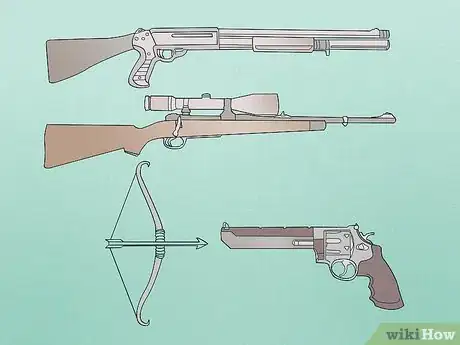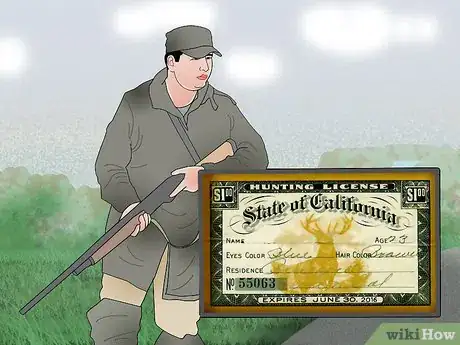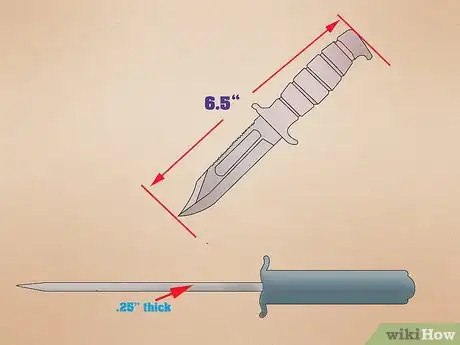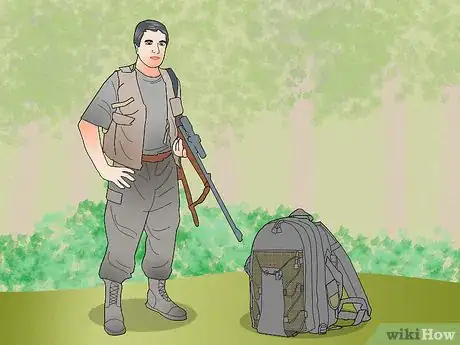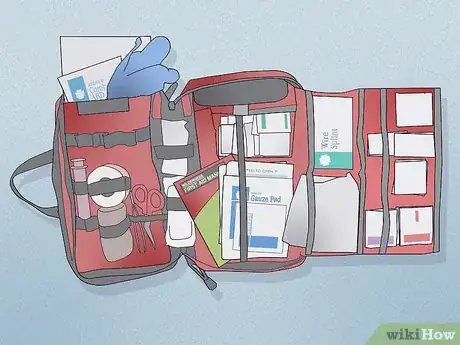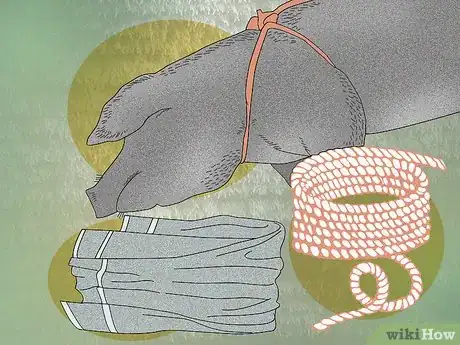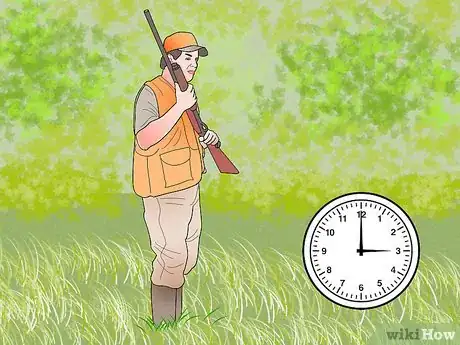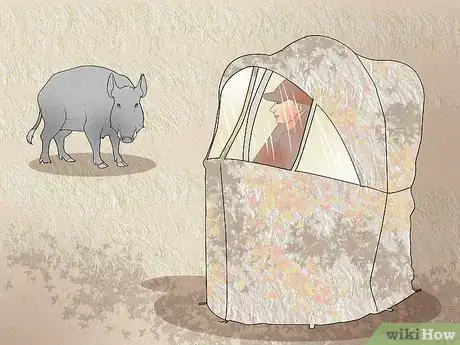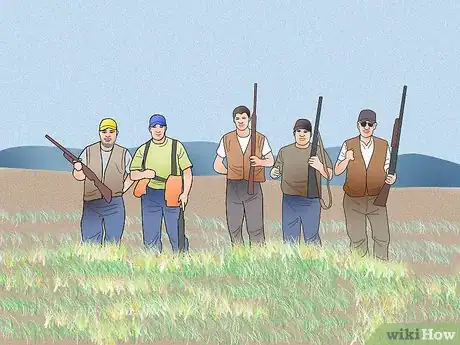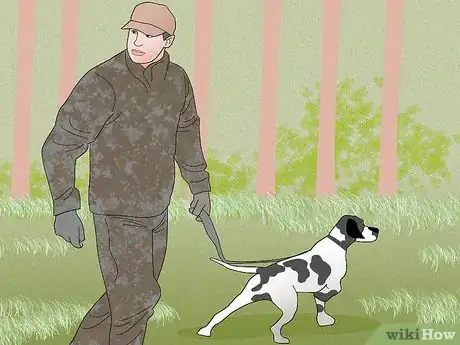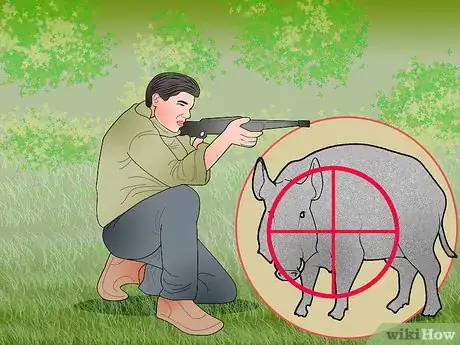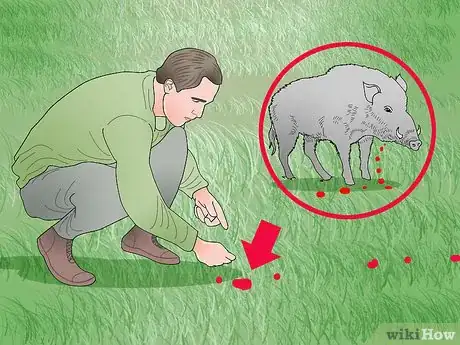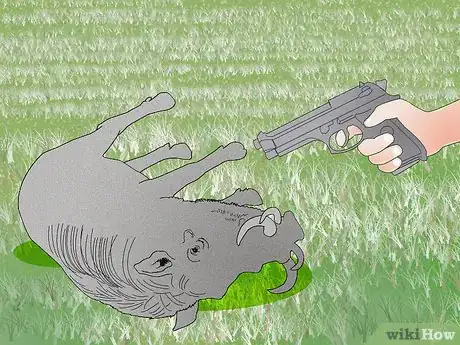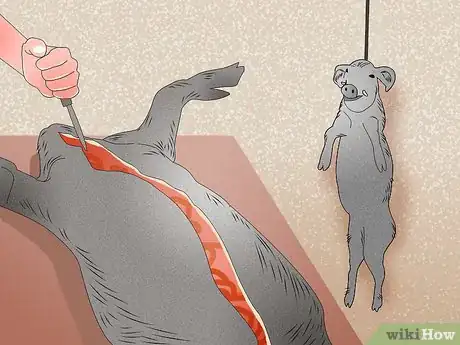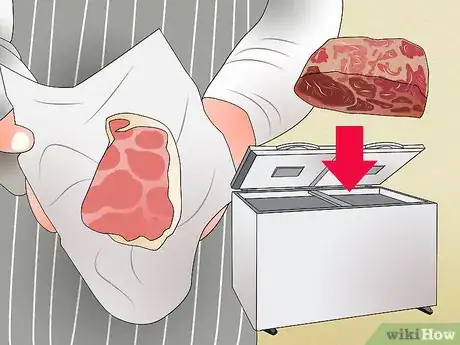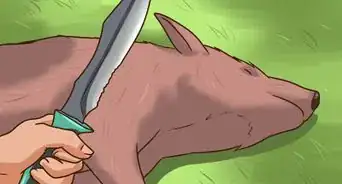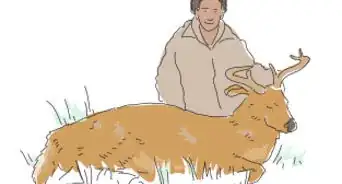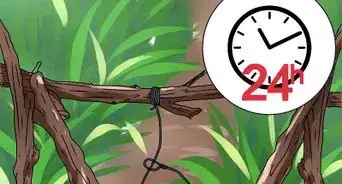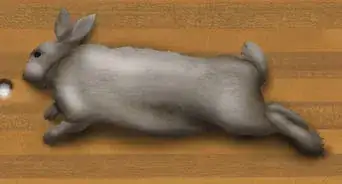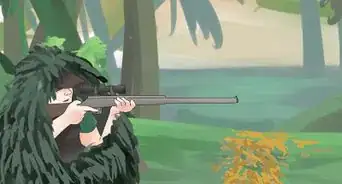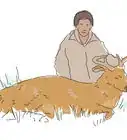This article was co-authored by wikiHow Staff. Our trained team of editors and researchers validate articles for accuracy and comprehensiveness. wikiHow's Content Management Team carefully monitors the work from our editorial staff to ensure that each article is backed by trusted research and meets our high quality standards.
wikiHow marks an article as reader-approved once it receives enough positive feedback. In this case, 88% of readers who voted found the article helpful, earning it our reader-approved status.
This article has been viewed 73,235 times.
Learn more...
Hunting wild pigs is a popular choice for hunters all around the world. Wild pigs tend to grow in such numbers that hunting them is almost always an available option. They often travel in large herds so finding them is rarely an issue. With all of the proper gear at hand and the right place picked out, hunting wild pigs is a straightforward and rewarding activity.
Steps
Preparing for the Hunt
-
1Choose your weapon. If you've already decided to hunt wild pigs, there's a good chance you've also made up your mind about what weapon you'll use. What's important here is to make sure that the caliber of weapon (or type of arrow) you've chosen will be enough to properly kill a pig. Your choice of weapon will also have a big impact on the distance from which you can fire.[1]
- While a rare choice as a primary weapon, many hunters will bring a handgun as a sidearm. Most useful for finishing a wounded pig, you'll want at least a .44 Magnum to do the job, with .454 and .50 caliber being the only other plausible options.
- Shotguns are a popular choice for hunters, though it shortens the distance from which you'll be able to shoot the pig. If looking for a small pig (under 90 lbs), than any gauge larger than 20 (including 20) will work. For larger pigs, a 12 gauge will be the only suitable option.
- Rifles are far and away the most popular choice for wild pig hunters, mainly for their ability to make a kill from a distance. The majority of calibers are also suitable for wild pigs (save for .22 and the 25-20 Winchester). Many hunters will include a scope for improved aim.
- If you're bow hunting, it's recommended that you use the heaviest pulling weight possible to hunt pigs. A bow will also limit the kill range to about 30 yards or less. Use of a razor-sharp broadhead arrow is highly recommended.
-
2Have your hunting license on hand. While this will completely depend on where you live and where you're hunting, most places around the world will want you to have a hunting license before you begin. However, there are often caveats in place for pigs in certain places, on account of their large numbers. Usually there are also allowances for private landowners to allow hunters on their property.[2]
- Be diligent in finding out just what laws and regulations affect your area. There are few outcomes for a hunt as bad as getting caught doing it illegally.
- Again, keep your license with you on the hunt. You never know when you'll run into law enforcement, so keeping it handy is rarely a bad choice.
Advertisement -
3Have a good knife. While not always a necessity on a wild pig hunt, a good knife is a dependable and adaptive tool. When pig hunting it's primary use will be to finish a wounded pig. In those instances, the quality of knife can make a tremendous difference. A well-made knife is also a great tool to have in general, and will last as long as you maintain it.
- For wild pig hunting, you'll need a knife with a good (no-slip) grip with a blade longer than 6.5 inches. It should be a fixed blade (not a flip knife) and should be kept well-sharpened.
- A thick blade with strong metal is important; be sure the blade is at least a quarter-inch thick.
-
4Have the right clothing. As with any outdoor activity, you'll want to wear clothes which are breathable and durable. Avoid cotton as much as possible, as it picks up and retains moisture like no other fabric. Look for fabrics designed to wick away moisture as well as ones designed to wash well (they're going to get dirty).
- There's not too many must-haves in terms of hunting clothes, but a bright hunter's vest is one of them, especially when hunting in groups.
- In terms of shoes there's really no better option than heavy duty boots. Be sure any pair of shoes you use is thoroughly waterproofed before wearing them on a pig hunt.
- You'll also want a sizable backpack (or at least one member of your hunting party will) to carry all the essentials besides your weapon.
-
5Keep a first aid kit. Advisable no matter what you're doing outdoors, a first aid kid is a must-have for hunting wild pigs. While the ideal hunt won't include any injury, wild pigs are notoriously dangerous and are unique in their choice for charging and fighting over running away. With caution and clean shots this shouldn't be a problem, but first aid kits are designed for the worst case scenario.
- Commercial first aid kits can be found at a variety of stores. Consider browsing your local hunting or sporting goods store for one.
- You can make your own first aid kit, just be sure to include a few key items:
- Square-sized gauze pads as well as 1.5-2 inch roll of gauze for treating wounds.
- Hydrogen peroxide for use as disinfectant.
- Safety pins for fastening bandages.
- Tweezers for removing splinters.
-
6Have equipment to handle the body. Once the hunt is complete and a kill is made, you'll need to take care of the body, whether or not you plan to save it as meat. Pigs are rarely small enough that you'll be able to handle the carcass on your own with just your hands. Equipping to haul the carcass from the hunting grounds is critical for any expedition.
- Fortunately the technology for moving the body is simple: a rope. Preferably of strong nylon, you'll tie the hog up and drag it from the grounds. A towel (that you don't care much for) may be desired to place under the carcass for transport.
- You'll also want a fairly heavy duty pair of rubber gloves (note: latex gloves will not do) for handling the body, especially when it comes time to skin and gut the carcass.
-
7Decide the time of day. One of the unfortunate features of any hunting is having to conform your hunt to the habits of the animal. Wild pigs spend most of the daylight hours resting in their “beds:” troughs they form in the ground to cool off in, usually within patches of dense foliage. They are most active in the late evening and early morning. So if you can manage it, a night hunt will be the most successful
- Be sure to equip for the occasion; lights or night vision goggles will be an absolute must. Never hunt at night without the appropriate lighting.
- Check your local hunting laws and regulations before launching a hunt at night. Some locations only allow pig hunting during daylight hours.
-
8Remove the scent from yourself and clothes. Pigs are like many other game animals and can pick up scents as a form of warning from quite a distance. You'll need to de-scent yourself and your clothes before your hunt to make sure the wild pigs don't catch wind of you before you even see them.
- Baking soda is a cheap fragrance remover. Take a shower with it by mixing it into some liquid, fragrance-free soap (don't use straight baking soda--it will irritate the skin). Wash your clothing with it by including baking soda where you normally would any other powdered detergent.
- Diesel fuel is another effective fragrance-remover, if a bit caustic for human noses. It's best use is if you're hunting from a blind, to remove any fragrances from the blind itself.
- There is also a variety of scents commercially available that will not only mask your scent but also attract wild pigs. It's still recommended to de-scent yourself, however.
Hunting Wild Pigs
-
1Look for the signs of wild pigs. As with hunting any animal, it starts with using the animal's own signs to track them. Fortunately wild pigs, more so than many other game animals, leave a variety of signs as to where they have been and where they might be going. Regardless of how you choose to hunt, it won't be any use unless you've got a general idea of where the pigs will be.[3]
- The first (and likely the first to come to mind) to look for are pig tracks, hoof prints, in the ground. They are near-circles with a slight indent at the front.
- You can distinguish them from deer tracks by the deer tracks' pointed end.
- Tracks going straight up a steep incline are a sure sign of wild pigs; other animals usually climb hills at an angle.
- Another sign of wild pigs will be their droppings. They come in clumps, with the size depending on the age of the animal. Using a rubber glove, you can examine them for some idea of where the pigs are feeding.
- Wild pigs often dig into the ground, looking for roots and other plant life to eat. Look out for sizable troughs in the ground, usually many in a small area.
- Wild pigs will also make indents in the ground near ponds or other still water. If you're near either, look out for what look like artificial holes with splattered water and mud around.
- If you see trees with bark removed in spots, or find hair on a tree, it's probably a sign of wild pigs; they scratch their itches by rubbing themselves on trees.
- The first (and likely the first to come to mind) to look for are pig tracks, hoof prints, in the ground. They are near-circles with a slight indent at the front.
-
2Hunt using a stand or blind. If you're already an avid hunter of deer or other game, you may have a hunting blind or stand which you like to use. Using a blind to hunt pigs is a viable choice, but not necessarily the best one on account of the pigs' highly mobile nature. Hunting from a blind is good choice, however, if you know the area well.[4]
- Be sure to have a good spot. Either near an obvious food or water source, you need to set up your stand where the pigs will at some point want to return to.
- You'll want to be downwind of where the pigs will eventually be, in order to avoid them catching your scent.
- One of the biggest benefits to hunting from a blind is it reduces the chance you'll have to face a wounded boar.
- You can use a store-bought pig call to lure pigs that you know are close. The best calls will be those which replicate a piglet's squeal, especially useful when a female is traveling with her young.
- You can also hunt from a blind by setting up where you think the pigs may be running from other hunters.
-
3Track and stalk the game. Perhaps the most traditional way to hunt pigs is to follow their tracks and signs, and take position once you've found them. This is certainly (in theory at least) one of the quicker methods to hunt pigs, as you'll always be on the move unless you have pigs in sight. Provided you're up for a hike as well as a hunt, tracking to hunt may be your best option.[5]
- Because hoofprints are so vital to this method of hunting, it's best to try and plan tracking hunts after a rainfall. The mud makes for a great environment in which to hunt wild pigs.
- If you know an area with heavy pig activity, plan a path which makes a circle around this area and move forward with every rotation.
- Tracking pigs is perhaps the most viable option if you're hunting only with a friend or two. Too large of a group would spook pigs you're trying to stalk. All of the other methods will require some tracking, but this is the only one which requires some surprise.
- Once you know you're near a group of pigs, do your best to become as quiet as possible. It's best to shoot from a static position for the best (and most humane) shot.
-
4Hunt using your group. Given enough people with the right transportation (some sort of all-terrain vehicle usually), you can put numbers to your advantage when hunting wild pigs. Essentially you'll be spreading out to cover a wider area, as well as provide a greater chance of flushing out any hogs hanging around.[6]
- Like hunting from a blind, you'll want to have a good understanding of the land you'll be hunting on. This will help you decide just how to organize your group with the landscape.
- Most likely you and your fellow hunters will spread out in a line, each person relatively far from the next (twenty or so meters). Unfortunately this method won't always result in a kill for yourself, but definitely increases the chances of multiple kills significantly.
- Alternatively, you can have one group of hunters find a spot to sit, stationary. If you know the area of high activity, locate one group on the far side away from the others, and have them push forward in a line to flush the pigs out towards the stationary hunters.
- More than any other method of pig hunting, you'll need to be incredibly aware of the direction of your shot, and absolutely sure there's nothing but foliage behind the pig you hope to shoot. Shooting a fellow hunter is an unfortunate but not totally unlikely consequence of group hunting.
-
5Hunt alongside dogs. Though not necessarily the choice for beginners (as you'll need a trained dog), hunting with dogs is more likely to yield results. Trained dogs will find the scent of the pigs and track them until they get one cornered; the dogs will bark so that they too can be found, and the pig dispatched.
- More than the other methods of hunting, hunting with dogs will require a bit of fitness, on account of needing to follow the dogs a bit of a brisk pace.
- Again, any dog used for this should be well-trained. Specifically, they should know to only chase the pigs and to avoid engaging them no matter what. Wild pigs, especially cornered, can be very dangerous.
- If hunting with dogs is something you're very interested in, it is possible to find dogs that come already trained, provided you find the right breeder.
- Consider buying some body armor for any dog you use to hunt pigs. They usually come in a few pieces (one for the neck, torso, etc.); this armor can really make a difference if a dog happens to be attacked directly.
Dispatching the Animal
-
1Aim and shoot. Regardless of how you've chosen to hunt, this is one step that will be the same throughout. If you're hunting pigs, this should not be your first time using whichever weapon you've chosen; a pig hunt is not the place to learn a new weapon. You're going to want to choose a weapon that you're confident you can make a clean, humane shot with when required.[7]
- No matter what weapon you're using, the best shot will be one to the heart and lungs, behind the pig's front shoulders. Aim for the shoulder itself, high on the pig's leg. This shot is the best because the cardiac/pulmonary damage will be such that you won't need to trail for long.
- Another plausible shot for those with high caliber weapons (bows and handguns not included) is the neck. You'll be aiming for halfway between the bottom of the ear and the top of the shoulder. When done correctly, this shot will sever the spinal cord and the animal will drop quickly.
- Never make a shot you're unsure of. A lightly wounded wild pig can quickly become a dangerous enemy; pigs are known for their preference to fight over flight. It is also inhumane to leave a non-fatal wound in a pig. Shoot only when you're cool and comfortable, and know where the bullet will land.
-
2Locate the shot animal. Once you've shot the wild pig, there's a good chance that it won't go down immediately. Many pigs wounded in the chest will run for a good bit before tiring and laying down to die. You have an obligation as a hunter to find and dispatch any pig you've shot, no matter what.
- If the pig has run off, mark the spot where it was when you first shot it. This will come in handy as a reference point.
- Focus on any blood the animal has left behind; usually the wound you've made will leave a trail of blood in the direction of the wounded pig. Look out for signs on trees and bushes as well.
- Be sure to not just focus on the ground, but look up and around as the pig may be a ways ahead of you, but still visible.
-
3Finish the animal if still living. As mentioned, a single bullet (even in the right place) may not be enough to kill a pig quickly and humanely. Once you've located the wounded pig, you'll need to finish it off out of mercy and respect. Take extreme care in doing so, as even a downed and wounded pig may pose a threat to you.[8]
- The best choice is a second shot, either to the head or again to the chest cavity, into the heart and lungs. Many prefer to do this with a handgun for ease of use.
- If the pig is relatively close to death and safe to approach, you may use a knife to cut the throat or stab the heart (angled thrust, under a front leg) to finish a wild pig.
-
4Field dress the carcass. If you're hunting wild pig, chances are you aim to keep the meat of the animal just downed. To do this you'll need to attend to the body quickly (gutted, skinned, and cooled)--pig carcasses can spoil quickly, especially in hot weather. To transport the carcass, tie your rope around the back hooves and drag it with you.
- For safety, you'll want to use rubber gloves when handling the pig carcass.
- Once you've got the carcass where you'd like to skin it, hang it with the head pointing up to begin the process. Using your knife, cut skin-deep all the way around the neck.
- From the cut made around the neck, use your knife to cut the skin in strips off of the pig's body. Once skinned, hang in a shady place to dry and cool (down from living, body temperature).
-
5Use proper care of meat. As with any meat, you'll want to take every precaution when storing and keeping game meat. Once the meat has cooled to room temperature and dried out some, it should be butchered and left to freeze, covered in butcher's paper.
- When handling the meat or cutting through it, be especially careful to avoid nicking either the bladder or the intestines. Cutting into either will spill the contents, ruining the meat.
- Come time to eat the meat, be sure to cook it completely (to 170 degrees Fahrenheit) so that any lingering parasites or bacteria are totally killed off.
- Any meat you don't eat needs to be disposed of quickly and correctly. Don't dump it and allow other wildlife or your pets to get to it.
Community Q&A
-
QuestionWould a bullet in the head from a pistol kill the wild pig instantly, or is it better to shoot its heart?
 Community AnswerIt is preferable to shoot the heart, as there is an increased probability of finding the lungs, which would also be deadly. Aiming for the brain could be unnecessarily cruel, as any shot not close enough to the spinal cord will cause immense pain (and could cause the boar to attack you).
Community AnswerIt is preferable to shoot the heart, as there is an increased probability of finding the lungs, which would also be deadly. Aiming for the brain could be unnecessarily cruel, as any shot not close enough to the spinal cord will cause immense pain (and could cause the boar to attack you).
References
- ↑ https://nrm.dfg.ca.gov/FileHandler.ashx?DocumentID=23231
- ↑ http://myfwc.com/hunting/by-species/wild-hog/
- ↑ https://nrm.dfg.ca.gov/FileHandler.ashx?DocumentID=23231
- ↑ http://www.outdoorlife.com/blogs/hunting/2012/03/dont-chase-wild-hogs-call-them-instead
- ↑ http://boarmasters.com/boar-hunting/
- ↑ https://nrm.dfg.ca.gov/FileHandler.ashx?DocumentID=23231
- ↑ http://www.skinnymoose.com/hogblog/2009/02/02/shot-placement-on-hogs-arguments-against-the-head-shot/
- ↑ https://nrm.dfg.ca.gov/FileHandler.ashx?DocumentID=23231
